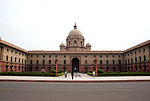Raisina Hill

Raisina Hill (IAST: Rāyasīnā Pahāṛī), often used as a metonym for the seat of the Government of India, is an area of New Delhi, housing India's most important government buildings, including Rashtrapati Bhavan, the official residence of The President of India on citadel at Raisina Hill and the Secretariat building housing the Prime Minister's Office and several other important ministries. The hill is seen as an Indian acropolis with Rashtrapati Bhavan as the Parthenon. Under the Central Vista project, the Prime Minister’s residence will be shifted behind the existing South Block, while the V-P’s residence is proposed to be relocated behind North Block. The Vice President's enclave will be on a site of 15 acres, with 32 five-storey buildings at a maximum height of 15 meters. The Prime Minister's new office and residence will be on a site of 15 acres, with 10 four-storey buildings at a maximum height of 12 meters with a building for keeping Special Protection Group. The project also includes converting North and South Blocks into public museums, creating an ensemble of new secretariat buildings to house all ministries. As a geographic feature, The "Raisina hill" is a slightly elevated portion 266 m (873 ft) high, about 18 m (59 ft) higher than the surrounding area and is located in a well-drained area between the Delhi Ridge and the Yamuna River with good drainage facility too. The Raisina Hill is open to the public and offers individual and group guided tours. The Raisina Hill buildings continue to attract thousands of visitors from across the world for the sense of grandeur they project.
Excerpt from the Wikipedia article Raisina Hill (License: CC BY-SA 3.0, Authors, Images).Raisina Hill
Rajpath, New Delhi Rakab Ganj (Chanakya Puri Tehsil)
Geographical coordinates (GPS) Address Nearby Places Show on map
Geographical coordinates (GPS)
| Latitude | Longitude |
|---|---|
| N 28.614 ° | E 77.205 ° |
Address
South Block
Rajpath
110004 New Delhi, Rakab Ganj (Chanakya Puri Tehsil)
Delhi, India
Open on Google Maps








